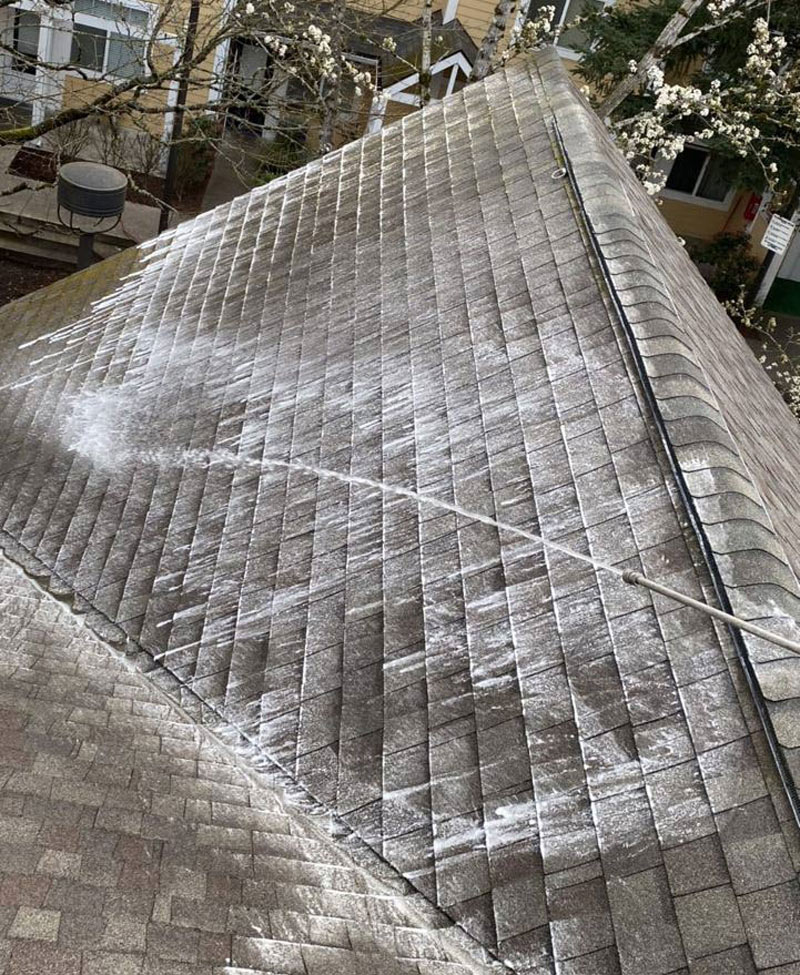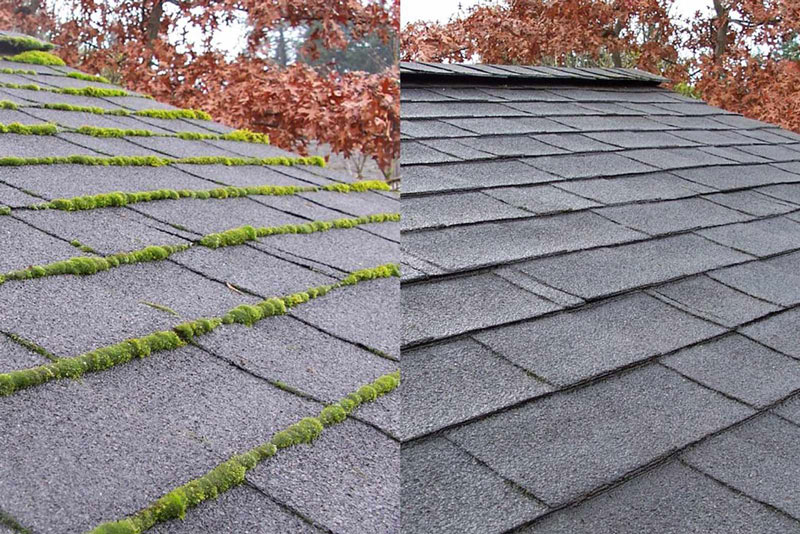Oregon Department of Agriculture Requirements for Moss Control
Proper use of pesticides is crucial to maintaining a healthy environment for people, plants and animals, while only eliminating the target pest. Because of this, the ODA requires licensing when businesses apply pesticides to people’s properties. A Commercial Pesticide Operator License is required by any business that makes pesticide applications. One of the requirements to obtain the Operator License is to have at least one employee who has their Commercial Pesticide Applicator License.
Let’s take a look at the different types of licenses that apply to Moss Control

Licenses
Commercial Pesticide Operator License
- At least one employee (corporation), owner (sole proprietor), or partner (partnership) must be licensed as a Commercial Pesticide Applicator
- License categories must match the type of pesticide work outlined in the applicator license
- Only those with the following licenses can perform any applications:
- Commercial Pesticide Applicator
- Pesticide Apprentice
- Pesticide Trainee
- Proof of insurance is required to maintain Operator’s License
Commercial Pesticide Applicator License
- Must be employed by a Commercial Pesticide Operator
- Needed to apply pesticides of any kind on property owned by others
- Needed to apply restricted-use pesticides to non-agricultural land or land owned by you or your employer
- Needed to apply any pesticides on school premises
- Needed to supervise trainees and apprentices
- To provide technical information about restricted-use pesticides, and only in the specific categories listed on the license
- Solicit pesticide services
- The Law & Safety exam is required as well as at least one category exam
Pesticide Trainee License
- Supervisor must have a Commercial Pesticide Applicator License and is responsible for training the licensed trainee
- Any applications must be within the licensed categories of the supervisor
- Supervisor must be on-site at all times of application and be able to reach trainee’s location within 5 minutes
- There are no exams needed to get this license
Pesticide Apprentice License
- Supervisor must have a Commercial Pesticide Applicator License and is responsible for training the licensed apprentice
- Any applications must be within the licensed categories of the supervisor
- The supervisor is not required to be on site; however, the apprentice must be able to contact the supervisor at all times during application
- The Laws & Safety exam is required to obtain this license
All licenses need to be renewed on an annual basis.
Exams
Prior to eligibility for obtaining a license, there are prerequisite exams that must be passed. No exams are required for the Trainee license. There is a minimum passing score of 70% for all exams. Categories can be added after licensing and exam scores are good for 2 years.

The Laws & Safety exam is required for the Applicator and Apprentice licenses. Here is an outline of what is on the exam.
Laws & Safety Exam
Label comprehension
- The label is the law
- Parts of the label including:
- Restricted-use pesticide (RUP) vs. general-use
- Precautionary statements
- First aid
- Signal words
- Active and other ingredients
- Directions for use
- Storage and disposal
Protective clothing and equipment
- General clothing requirements
- Respirator types and uses
- Decontamination and cleanup
First aid and toxicity
- First aid
- Signs and symptoms
- First aid and the label
- What to do in an emergency
- Toxicity
- LD50 and LC50 values
- Acute vs. chronic effects
- Routes of exposure
- Cholinesterase monitoring
Federal and State laws and regulations
- Agency responsibilities
- Federal Insecticide, Fungicide, and Rodenticide Act (FIFRA)
- Federal Food, Drug and Cosmetic Act (FFDCA)
- Oregon Revised Statute (ORS) 634 & Oregon Administrative Rule (OAR) 603
- Worker Protection Standards (WPS)
- Occupational Safety and Health Act (OSHA)
- Hazard Communication Standard (HCS)
- Endangered Species Act (ESA)
- License types and requirements
- Certification periods
- Prohibited acts and civil penalties
State recordkeeping requirements
- Recordkeeping elements
- Retention time
Integrated Pest Management (IPM)
- Definition of IPM
- Advantages of IPM
- Types of control methods
- Scouting and monitoring
- Economic threshold
- Economic injury level
Environmental considerations
- Drift
- Particle drift
- Vapor drift
- Groundwater contamination
- Pesticide transport in the environment
- Soil types
- Wildlife
- Pesticide persistence
- Factors influencing persistence
- Processes for degradation
Pesticide transportation, storage and disposal
- Storage
- Facility requirements
- Keep site safe
- Transportation
- Where in vehicle to carry pesticides
- Placarding and shipping documents
- Material Safety Data Sheet (MSDS)
- Spills
- Control
- Contain
- Cleanup
- Oregon Emergency Response System (OERS)
- Disposal
- Disposal of unwanted pesticide product
- Disposal of pesticide containers
On top of the Laws & Safety exam, the Industrial, Institution, Health and Structural (IIHS) Category has the Moss Control exam, which is required to get the Applicator License to use pesticides for Moss Control. Here is an outline of what to expect on the exam.
IIHS Moss Control Exam:
Environment
- Groundwater and surface water contamination
- Pesticide transport in the environment
- Pesticide persistence
- Factors influencing persistence
- Drift
Calculations
- Calculations
- Calculate size of area to be treated
- Rate of application
- Mixing percent solutions
Integrated Pest Management
- Advantages of using an integrated approach
- Chemical vs other control methods
- Scouting and monitoring
Pest characteristics (lifecycles, identification and control)
- Algae
- Moss
- Lichens
- liverworts
Safety and handling
- Pesticide transportation, storage and disposal
- Protective clothing and equipment
- General clothing requirements
- Decontamination and cleanup
- First aid
- Signs and symptoms
- First aid and the label
- What to do in an emergency
Pesticide characteristics
- Zinc flashings
- Copper flashings
- Copper sulfate
- Zinc chloride
- Sodium pentachlorophenate
- Herbicides (with directions for moss control)
Application or control techniques
- Installing flashing or wire
- Granular products
- Liquid products
Label comprehension
- The label is the law
Parts of the label including:
- Restricted-use vs general-use
- Precautionary statements
- First aid
- Signal words
- Active and other ingredients
- Directions for use
- Storage and disposal
- Be able to answer word problems and calculations based on a sample label
Here are some sources for studying the material on the IIHS Moss Control exam
National Pesticide Applicator Certification Core Manual
Maintenance
Recertification credits are required for maintaining eligibility for renewing licenses. If these requirements are not met, then all appropriate exams will need to be retaken and passed in order to renew.
For Commercial Pesticide Applicators License renewal, here are the recertification requirements:
- Accumulate a total of 40 credit hours during the 5-year certification period with no more than 15 credit hours accumulated per calendar year
For the Pesticide Apprentice License renewal here are the requirements:
- Accumulate 8 credit hours of training that has been accredited by ODA each year, with 4 of the 8 hours being “CORE” programs
Conclusion
Proper training and licensing are an important part of applying pesticides. The potential harm of these substances can be minimized by correct use, storage, transportation, knowledge of products and safety precautions, all of which is covered in the licensing process.
SNUGS is approved by the Department of Agriculture to apply treatments and remove moss. We use compounds that are registered with the EPA, and are proven to turn the moss inert. You can trust the knowledge and experience we have in following proper safety guidelines while getting the job done right.

Our treatment is applied in liquid form, and is recommended to be applied during the spring months, but can be applied year around. Whether your roof is Metal, Tile, Slate, Composition, or Cedar Shake, we can remove the moss. SNUGS has been removing moss from roofs for many years and has come across all different types of roofs. Some roofs need to be pressure washed, while other roofs will be destroyed from pressure washing. We can handle either situation and do the best to keep your roof in good condition. Once we clean the moss off the roof, we will clean the gutters and clean the moss from the ground. On composition roofs we will apply granular treatment to help prevent any roots or spores from continuing to grow.
Snugs Pro Wash, Inc, dba SNUGS Services, has been providing high quality Pressure Washing Services in Portland, OR since 1995. Started as a residential pressure washing and roof cleaning service, SNUGS is now one of the leading exterior cleaning companies in the Northwest. From our humble beginnings as a man with a truck and a trailer we have grown to become a multi-million dollar company serving corporate customers, name brands, and mom and pop companies alike.